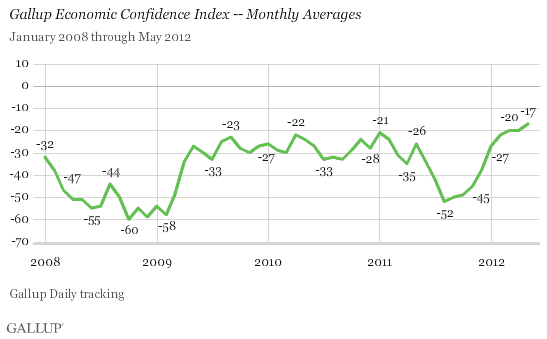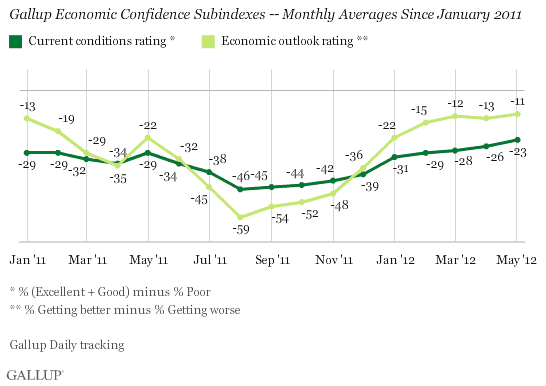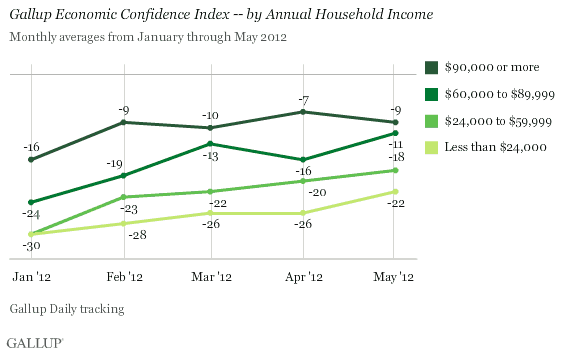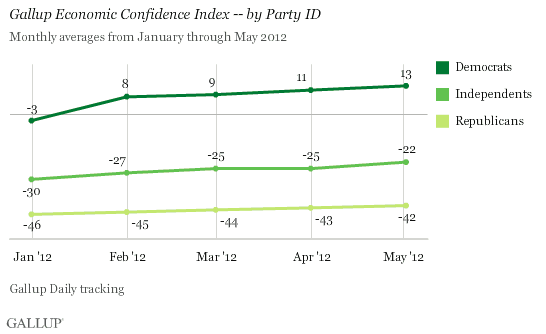PRINCETON, NJ -- Gallup's Economic Confidence Index averaged -17 in May, improved over the -20 averages recorded in March and April, and the highest monthly average since Gallup began Daily tracking in January 2008.

More broadly, confidence in May was above -20 each week, averaging -18 in the week ending June 3.
These findings preceded the government's June 1 labor report showing unexpectedly tepid job growth and an increase in the U.S. unemployment rate to 8.2%. Although this news could potentially trigger another downturn in Americans' economic confidence, thus far that hasn't occurred. Gallup Daily tracking from Friday through Sunday, with all interviewing conducted after the jobs data were released, showed the Gallup Economic Confidence Index holding steady at -17.
Outlook and Current Ratings Both Up Slightly
Both components of the index -- Americans' ratings of current economic conditions and their perceptions of whether the economy is getting better or getting worse -- improved slightly in May. The -11 economic outlook rating reflects 42% of Americans saying the economy is improving and 53% saying it is getting worse. At the same time, 16% of Americans say the economy is in excellent or good shape, while 39% consider it poor, resulting in a -23 current conditions rating.

Upper-Income Americans' Confidence Declines, While Others' Increases
Perhaps accompanying the stock market's significant losses in May, confidence among the highest-income Americans fell slightly between April and May, while it improved at least slightly among all other income groups. Even so, Americans making $90,000 or more annually expressed the most confidence (-9) in May, and Americans earning less than $24,000 expressed the least (-22).

Confidence also differs by party ID, with Democrats (+13) mildly positive about the economy and Republicans (-42) and independents (-22) negative. Since January, Democrats' confidence has improved the most and Republicans' the least, with independents showing moderate improvement.

Bottom Line
The three-percentage-point increase in Americans' economic confidence in May is the best one-month change since February, and restores confidence's upward trajectory that started last fall. The stakes around its continuing to rise could be high, both economically and politically. Some economists are interpreting the latest jobs report as a symptom of a broader global economic slowdown, and a decline or continued stagnation in Americans' economic confidence could further hamper U.S. economic growth.
Also, at -17, the monthly Economic Confidence Index is now just shy of the level Gallup has determined may correspond with an increase to 50% in President Barack Obama's job approval rating. Thus, at a time when Obama's re-election may hinge on confidence's rising at least a bit further, the economy is sending negative signals to consumers. The good news for the economy and for Obama's election campaign team, however, is that thus far into the period after last week's jobs report, Americans' economic confidence has not faltered.
Gallup.com reports results from these indexes in daily, weekly, and monthly averages and in Gallup.com stories. Complete trend data are always available to view and export in the following charts:
Daily: Employment, Economic Confidence, Job Creation, Consumer Spending
Weekly: Employment, Economic Confidence, Job Creation, Consumer Spending
Read more about Gallup's economic measures.
View our economic release schedule.
Survey Methods
Results are based on telephone interviews conducted as part of Gallup Daily tracking May 1-31, 2012, with a random sample of 14,574 adults, aged 18 and older, living in all 50 U.S. states and the District of Columbia.
For results based on the total sample of national adults, one can say with 95% confidence that the maximum margin of sampling error is ±1 percentage point.
Interviews are conducted with respondents on landline telephones and cellular phones, with interviews conducted in Spanish for respondents who are primarily Spanish-speaking. Each sample includes a minimum quota of 400 cell phone respondents and 600 landline respondents per 1,000 national adults, with additional minimum quotas among landline respondents by region. Landline telephone numbers are chosen at random among listed telephone numbers. Cell phone numbers are selected using random-digit-dial methods. Landline respondents are chosen at random within each household on the basis of which member had the most recent birthday.
Samples are weighted by gender, age, race, Hispanic ethnicity, education, region, adults in the household, and phone status (cell phone only/landline only/both, cell phone mostly, and having an unlisted landline number). Demographic weighting targets are based on the March 2011 Current Population Survey figures for the aged 18 and older non-institutionalized population living in U.S. telephone households. All reported margins of sampling error include the computed design effects for weighting and sample design.
The questions reported here were asked of a random half-sample of respondents for 29 nights on the Gallup Daily tracking survey.
In addition to sampling error, question wording and practical difficulties in conducting surveys can introduce error or bias into the findings of public opinion polls.
For more details on Gallup's polling methodology, visit www.gallup.com.
